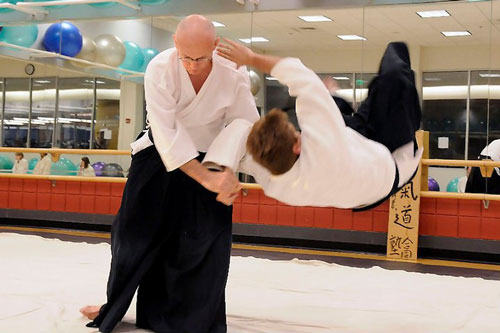Yoko Ukemi
In Aikido, the most advanced fall is known as a break fall or high fall (in Japanese, “yoko ukemi”, lit. “side fall”). This is the big spectacular fall that you often see in advanced Aikido demonstrations where uke (the person receiving the technique) attacks nage (the person performing the technique) at high speed and then is thrown crashing to the ground. Uke invariably bounces back to his or her feet unharmed. The reason they can do so safely is that they have learned to take yoko ukemi or a break fall.
There are many ways to learn yoko ukemi. The most common form is where you learn to come down on your side and release the energy of the impact through the length of your body, arms, and legs, usually accompanied by a loud slap on the mat. This is an effective method to release energy in the dojo, and will allow you to safely take big falls with little risk of injury.
The biggest disadvantage of taking a hard break fall is that it’s very dangerous to take on a hard surface. Every Aikido practitioner knows what it feels like when you get thrown near the edge of the mat and do a hard slap on a firm surface like wood or cement. It hurts! Try slapping a bare floor as hard as you can sometime, and you’ll see what I mean.
This article doesn’t focus on this kind of energy dispersion fall, instead it teaches you how to take a soft break fall. In a soft yoko ukemi, uke turn his or her body sideways in order to bring their back arm around to touch the ground first followed by the rest of the body in a soft curving motion. It finished with a gentle rollout to the opposite side.
You can practice this without a partner by doing a stretch roll that ends in a sideways (yoko ukemi) rollout as shown below.
So how do you do this with a partner? It use the same basic movements. You just have to learn to do them when receiving a technique from your partner.
If you’ve already programmed your muscle memory to learn a hard break fall, you’ll have a hard time completing the soft yoko ukemi. But with time, I believe everyone can soften up their break falls by learning to blend with the ground (in true Aiki fashion!), rather than impacting against it. Here are three steps that can help you work up to taking soft break falls.
Step 1: Prone Partner
Have your training partner lie prone on the ground face down. Then kneeling at their side, place your forward hand against their ribs with your thumb turned towards their hip.
Lean across your partner and bring your forward shoulder (the same one as the hand on their ribs) to the mat, then roll across your shoulders to the opposite arm. Finish by rolling out to the opposite side.
As much as possible, try to avoid putting your weight on your partner. Your weight should go on the floor, not onto their back.
Step 2: Crouching Partner
Next, try from a higher position. Have your partner crouch on their hands and knees. From there it’s very similar to Step 1.
From a standing position, place your forward hand against their ribs with your thumb turned towards their hip.
Lean across your partner and drop your head and forward shoulder towards the mat. Again, try to put as little weight as possible on your partner’s back. You don’t want to roll across their back. You want to “slither” down their side.
Important: Your free hand (the back one) should be the first part of your body to touch the ground.
Once your hand touches the mat, your arm and the rest of the same side of your body will naturally follow in a rollout.
Step 3: Kneeling Partner
The next level is to take the fall from standing with your partner in a kneeling position.
Begin by facing your partner, and grasping each other under the same arm (right arm to right, or left arm to left). Then lean over your partner’s leg, tighten your core, and think about sending your head to toes. Then drop your head towards the mat, getting your forward shoulder as close to the mat as possible before completing the fall. Again your back hand should be the first part of your body to touch the ground, followed by the rest of your body in a soft curving motion.
As you make the fall, don’t put all your weight on your partner’s leg or they will collapse. Your should have very little contact with your partner other than the mutual grip. There will be nothing to rely on but good form when you are taking this fall from a technique.
Once you have become comfortable with these three steps, you will soon be able to take a high fall from nearly any technique and end with a soft finish.

